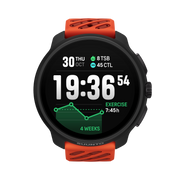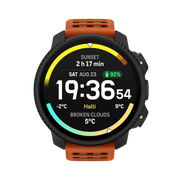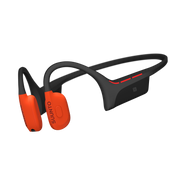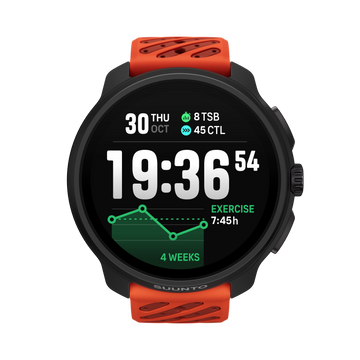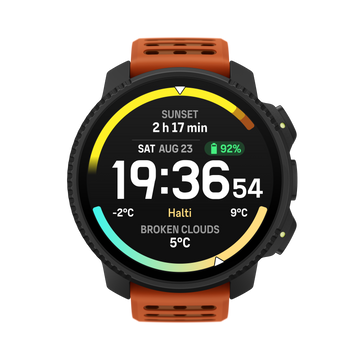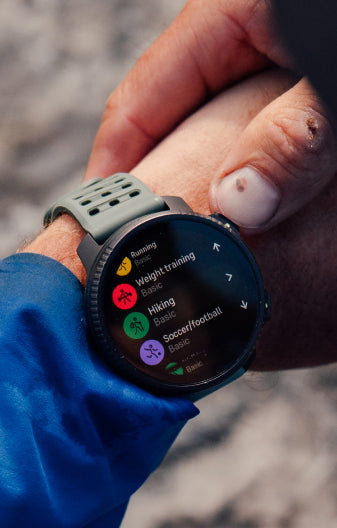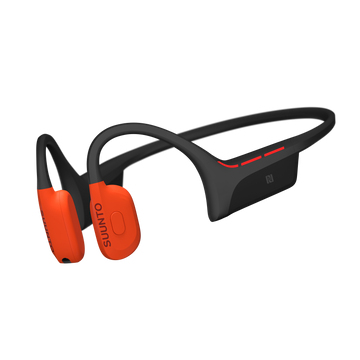

Suunto-blogg

Four pointers for running while pregnant
© Lymbus/Sergi Colomé
Being pregnant has meant Emelie Forsberg has had to make some adjustments to her schedule, and reduce the volume of her training. However, it hasn’t stopped her running. While she is taking more care, she is trying to stay active for as long as she can.
“I think (running while pregnant) is so individual, so you can’t compare one woman to another,” Forsberg says. “My first priority is always to listen to my body, especially now that I’m pregnant. I will try to stay active as long as I can. I don’t have any niggles or problem so far.”
According to Andrew Shennan, professor of obstetrics at Kings College in London, running while pregnant is perfectly safe if not overdone. Many people, he says, have misunderstandings about women’s bodies during pregnancy. They are capable of more than you might think.
“Pregnancy is quite a profound state in terms of how it changes your body, however it’s not that delicate,” Shennan says. “In fact, all the evidence says that staying fit and healthy and continuing exercise is a perfectly reasonable thing to do.”
© Lymbus/Sergi Colomé
1. Running is safe (within reason)
Shennan and his colleagues did a study on 1200 pregnant runners. The study compared those that stopped running with those that continued, and then compared those that continued into different phases of pregnancy, and also by their running volume, and those that stopped. The study found the pregnancies of women who chose to give up running were no different from those who continued to exercise throughout their pregnancy.
“All the evidence on moderate exercise and recreational exercise is that doing it regularly and consistently does not influence when you go into labour, or the way your baby grows and develops,” Shennan says. “You can be reassured that mild exercise is perfectly reasonable.”
2. It’s actually a good thing
Not only is moderate, regular exercise safe, it’s also a good thing. Shennan says there is good evidence that being a good weight and physically fit is helpful for pregnancy and during labor.
“From a general point of view we encourage women to exercise about 30 minutes everyday,” he says. “Entering pregnancy at an optimal weight is a very good prerequisite for a healthy pregnancy. We know that healthy pregnancies create healthy children. Being fit and healthy will programme your baby in utero for lifelong health.”
Professor Andrew Shennan is Professor of Obstetrics at King’s College London, based at St. Thomas’ Hospital.
3. Don’t push it
Yes, running is safe and even healthy, but caution is required. Because pregnant women pump 40 % more blood, their hearts have to work harder, increasing their average heart rate.
“The placenta is very sensitive to blood flow and doesn’t have autoregulation like other organs have,” Shennan says. “This means that if you are becoming a bit hypoxic (low in oxygen), it will have a direct effect on the placenta. Therefore, it’s really important not to push it. If you are running in the red zone that’s probably not a good thing. I would stay within your comfort zone, and listen to your body.
“Remember the benefits you get from exercising at suboptimal levels are often underestimated. Focus on maintaining your fitness while pregnant rather than trying to gain.”
4. Avoid falling at all costs
Hormone activity in pregnancy softens ligaments, and reduces bone mass, increasing the risk of injury. The ability to balance and posture change in the second and third trimester. All of this means women can become more injury prone.
“The lesson is be careful and not to do crazy things,” Shennan says. “The one big thing to avoid is trauma. We know that trauma, direct impact to the uterus, is a bad thing. If you have a little fall, and you knock your bump, there can be what we call subclinical bleeds behind the placenta and they can build up and cause a catastrophic event a day or two later. So even minor trauma is not good thing.”
Final word: enjoy your running
When Shennan was conducting the study of 1200 pregnant runners, one woman contacted him to ask if she should continue running. She said she had cut down her training volume to 20 km a day. Shennan said he didn’t know whether that was safe. She continued running in this way and encountered no problems during her pregnancy or the birth.
“As an obstetrician, I’m not encouraging woman to do that because I think it’s probably a bit much,” he says. “However, I do encourage pregnant woman to carry on doing their accustomed exercise. Just be prepared to slow down a bit.”
Lead image: Photo by Curtis MacNewton on Unsplash

3 Ways to Motivate Yourself to Train This Winter
On the whole we endurance athletes are a pretty self-motivated bunch. But even endurance athletes are only human, and as a result we suffer from the same fluctuations in “get up and go” as everyone else from time to time. These dips in motivation can range from the nagging desire to skip training for a day or two to full on slumps where you lose your workout mojo altogether for extended periods of time.
And this time of the year can be particularly challenging from a “mojo” point of view because, for the most part, the “A” races for the year have disappeared into the rear view mirror but next season is still a good way off over the horizon.
There are also dark mornings and evenings with often colder, wetter weather to contend with (for those of us in the Northern Hemisphere at least). At this time of the year it’s easier than ever to just skip training altogether.
Don’t get me wrong, I do believe in taking a decent end-of-year break if you’ve had a long, hard season. This is crucial for mental and physical recuperation. But, assuming that your planned downtime is coming to an end sometime in the near future, I thought it might be a good time to offer up a few tips gleaned from more than 20 years of tricking, cajoling and persuading myself to go out and train when frankly I’d much rather have hit the snooze button or spent more time working on the Homer Simpson-esque butt indentations in my sofa instead.
Set your next goal ASAP
Over the years I’ve learned that lining up your next significant goal is the best way to motivate you to train. It’s why I’ve tried to carry on doing a fairly big event each year even though I’m nowhere near as competitive as I used to be.
I simply find that without something fairly challenging in the diary in the not too distant future, I am far more likely to give in to the urge to skip a session when I just don’t feel like it. Without a significant goal on the horizon, I find that something of a downward spiral kicks in. Missed workouts lead to a significant drop in fitness levels followed by similar drop-offs in mood, self-confidence and overall productivity in life.
In contrast, when I have a decent high-level goal in place the opposite tends to happen. Aiming for the goal has a positive “double-whammy” effect on my motivation and willingness to put the work in. It gives me something very positive to visualize and strive toward when I’m feeling motivated and up for training anyway, acting as a kind of multiplier of effort and enjoyment on those days.
And even more importantly, it does a great job of mildly scaring and pressuring me into making that crucial first step out of the door on those days where I’m feeling less than up for it. That’s largely because I’m fearful of the consequences of not doing so; namely falling short of the goal in some way.
I’m actually going through the process of choosing a couple of goals for the year at the moment. If you’ve not set your mind to what you want to be doing this year yet, I’d definitely recommend doing so soon.
Plan to train with other people
Training with other people adds the pressure of not letting them down and this alone is a powerful motivator. Training with others can also be a lot of fun and it can help distract you a bit and give you another, more sociable reason to go training.
I’ve always found evening training to be the hardest to get motivated for. I’ve therefore taken to arranging to go training with other people on days where my work schedule dictates that I have to put sessions in after dinner rather than first thing in the morning (which I definitely prefer).
More often than not, the pressure of having to show up and not let someone else down is the deciding factor in getting me out and putting in the miles. And, somewhat unsurprisingly, I almost always find that I either enjoy the training once it’s underway or at the very least get a sense of satisfaction from it once it’s done.
Plan tomorrow, tonight.
Having the discipline to spend two minutes at the end of each day thinking about what training you’re going to do the next day can be hugely beneficial.
When you’re working to a set training plan this mental checklist is nothing more than a brief chance to think through what your program has in store; to make sure you feel like you’re up to it and to check you have everything you need ready (kit/equipment laid out or packed, alarm set for the right time, any foods and drinks prepared etc).
This reduces the chances of anything small or silly preventing you from getting the job done the next day and it allows you to adapt your plan if you feel you need to.
When you’re not working to a long-term structured plan (as can be the case at this more relaxed time of year), taking a couple of minutes to plan out what you intend to do tomorrow, and when you intend to do it, is even more important. It dramatically increases your chances of actually knuckling down and doing some productive training.
I’ve done a fair bit of reading on this subject (as well as thinking about my own tendencies) and I think this is largely because we have 3 different “selves”: our Past Selves, Present Selves and Future Selves. The implications of this theory go way beyond training, but here’s my extremely basic interpretation of how it applies to athletes:
Your Present Self almost always wants to do something that’s easy and rewarding right now e.g. hit snooze and stay in the warm bed, or stay parked in front of the TV. However, what your Future Self would actually benefit from most of all is doing something harder right now, i.e. getting your kit on and going training, as this will result in your Future Self being fitter in the long run.
In other words, your Future Self needs your Present Self to take some pain now for gain later on, whereas Present Self is far more interested in avoiding the pain in the immediate term. It’s as if you’re actually two different people with two different sets of goals.
So, when you sit down the night before the following day to mentally commit to what training you’ve got planned, what you’re actually doing is proactively putting your Future Self’s best interests to the fore whilst you’re not feeling the strong pull of Present Self’s desires.
When the alarm goes off the following morning, you wake up having effectively made a pact with your Past Self to get up and go to give your Future Self the best shot at hitting their goals. This makes it quite a bit harder for Present Self to take the reigns and simply turn off the alarm and roll over.
The psychology of human motivation is clearly more complicated than this simplification, but I do know from my own experience that thinking about things in this way (and pre-agreeing the following day’s training the night before with myself) is a very helpful tool for getting me up and out of the door.
Success with endurance training is largely a product of the consistency with which you can grind it out over many months, so I hope that these tips help you get out of the door just a little more regularly in the coming weeks and contribute to you starting the new year with the best possible chance of having a great season.
This article by Andy Blow, a coach and a triathlete, was originally published on trainingpeaks.com.
TrainingPeaks provides you in-depth analysis, planning tools and coaching services to help you reach your goal. Track your workouts with your Suunto watch. Afterwards analyze your heart rate, power, pace and other data with TrainingPeaks on web or in mobile and progress towards your goals.
READ ALSO
TAKE THE LONG LOOK: HOW TO PLAN (VERY) FAR AHEAD IN ORDER TO REACH YOUR GOALS
3 THINGS YOU NEED TO DO BEFORE SETTING YOUR NEXT RACE GOAL

Fuelling the engine: Talking nutrition with Ryan Sandes
Avocados are a staple in Sandes’s diet. © Craig Kolesky / Red Bull Content Pool
Back home in his native South Africa, ultra runner Ryan Sandes is partial to a good braai (the South African version of a barbeque). While he generally eats whole foods most of the time, Sandes avoids getting strict or uptight about his diet. He takes a pragmatic approach.
“I believe it's important to enjoy life as well,” he says. “I don’t weigh x amount of protein, and x of carbs, I just try to eat a balanced diet with as many whole foods as possible. I try to listen to what my body is craving.”
Despite being from meat loving South Africa, Sandes and his wife Vanessa have drastically reduced their meat consumption to only once or twice a week. Instead, they focus on eating unprocessed, natural food.
“As an athlete it’s very easy to slip into taking lots of recovery shakes to try to get the goodness back into your body,” Sandes says. “But I don’t think you can replace eating good whole foods.”
Sandes ran the Great Himalayan Trail this year. © Dean Leslie / Red Bull Content Pool
In busy times
Forward planning is essential for athletes. And having a good meal plan is just as important as having a clear training plan.
Sandes often makes a big dish, with multiple portions, at the beginning of the week so he has something easy available if it’s a busy week. It’s helpful doing this, he says, because of the tendency to get a little lazy, especially later in the week.
“I often eat quite a lot of eggs, and avocados and salad, things that are easy to put together,” he says.
Sandes (and his dog) remains partial to a braai (barbecue). © Ryan Sandes
Go to meals
Sandes enjoys pizza so, when he needs an easy meal, he buys locally made pizza bases, smothers them vegetables and salad, and bakes them. Burgers, smoothies, rye bread with honey, muesli and plenty of boiled eggs are all part of his regular diet, too.
And his secret supplement is bone broth.
“These days in first world countries people eat the best cuts of meat, whereas way back in the hunter-gatherer days, if they hunted a buck they would eat the entire animal, including boiling all the bones and drinking the broth,” Sandes explains. “A lot of the good meat cuts don’t have all the essential fats, but bone broth has that. It’s not my favourite thing, but it’s great for recovery.”
The Sandes superfood grain salad recipe
Grains:
1 cup of quinoa1 cup of sorghumHalf a cup of milletHalf a cup of buckwheat
Boil all the grains separately as they all have varying cooking times.Add a can of drained and rinsed chickpeas and a can of drained and rinsed lentils.Let the grains cool down and add some lemon juice and good quality olive oil. The above amounts make quite a big bowl but you can keep it in the fridge and decant from it all week for lunch and dinner!
Other ingredients:
Chopped up avocado pearRocket and other lettuce leaves Baby spinach leavesFeta cheesePitted olivesBaby tomatoes
Salad dressing:
1/4 cup of balsamic vinegar1/2 cup of good quality cold extracted olive oil1 teaspoon of honey1 teaspoon of whole-grain or Dijon mustardOne clove of crushed fresh garlicSalt & pepper to taste
Blend all the salad dressing ingredients and lightly drizzle onto your salad. For more of an animal protein punch, add slices of grilled chicken, beef or tuna. Optional extras: drained and rinsed can of corn, chopped up fresh basil, drained and rinsed butter or cannellini beans, cut up cucumber, half a hand-full of dried cranberries.
Lead image: Photo by Jaco Pretorius on Unsplash
Read more stories about nutrition:
Fuelling the engine: A common sense approach to nutrition
Fuelling the engine: Talking nutrition with Melissa Hauschildt
Fuelling the engine: Talking nutrition with Lucy Bartholomew

3 Things You Need to Do Before Setting Your Next Race Goal
In the 1960s, Stanford professor Walter Mischel set out to do an experiment. He tested hundreds of 4 to 5-year-olds on what turned out to be a key component to future success in work, health and life. Researchers brought each subject (a 4 or 5-year-old kid) into a private room and set a single marshmallow down on the table directly in front of them. The researcher then let the child know that they were going leave the room and if they didn’t eat the marshmallow sitting in front of them, they would get another marshmallow when the researcher came back into the room. The researcher then left the room for 15 minutes to let them decide: one marshmallow now or two marshmallows later?
DELAYED GRATIFICATION
In the past couple years you’ve probably noticed an inordinate amount of articles, podcasts, and TED Talks on the topic of happiness and life satisfaction. When people talk about being “happy,” there two different aspects to this concept.
There is happiness that we find on a daily basis through joyful activities, and then there is the happiness we find in having a greater meaning in our life that contributes to overall life satisfaction. There is feeling happiness in your life and then there’s feeling happiness about your life.
Happiness about your life sometimes includes going after bigger goals. Pushing yourself to see what you’re truly capable of. Working toward something that brings you both joy (because you enjoyed the pursuit) and satisfaction (because you had to work hard to get it). At some point when you go after a big goal you will be required to trade the immediate perceived reward right now for the bigger reward down the road. Big goals can mean big sacrifices; like not eating the marshmallow sitting in front of you.
If you’ve ever had an unfinished goal, you know how frustrating and heartbreaking it can be. You were on the path to your goal, took an unexpected side trip, and never found the road leading back to it.
What athletes don’t always know is that when they don’t accomplish a goal, they didn’t necessarily fail at the goal—they more likely failed at their goal-setting strategy. Here are three essential and research-proven goal-setting techniques for delaying gratification and holding out for the bigger reward:
HAVE A PLAN
You need to know exactly what you want and exactly how you’re going to get it. It’s worth putting in the time to formalize your goal and get specific with your strategy. The more specific you are with your vision and your plan, the more likely you are to take action on it.
WRITE IT DOWN AND SHARE IT WITH FRIENDS
Athletes who do these two things increase the probability of actually accomplishing their goals. Telling people about your goal and writing it down are added accountability factors that can increase the likelihood that you will follow through with your goals.
KNOW YOUR WHY
Why this goal and why now?
Why is this important to you?
How does this goal connect to your values and the person you want to be?
When you think to yourself “I don’t know if I can do it today” and you’re trying to find your motivation, connecting to your why can be a powerful reminder of what’s really important to you and helps you make a decision from that place. It helps you hold out for two marshmallows.
And speaking of marshmallows—you might be wondering what the kids did when the researcher left the room:
Some kids had no problem at all waiting patiently for their second marshmallow. Others immediately grabbed the marshmallow and shoved it in their mouths. And then some of the kids came up with strategies like covering their eyes and sitting on their hands to try and hold out for the bigger reward.
What’s really fascinating are the follow-up studies. Over the course of 40 years after the initial experiment, some interesting differences emerged between the children who were able to delay gratification and choose two marshmallows later versus the children who chose one marshmallow immediately.
The research from this study and subsequent studies on delayed gratification are pretty clear; the ability to delay immediate gratification is essential for success. You set goals to fulfill dreams, to move from wishing something would happen to making it happen. And when you are truly committed to your goal, there is no amount of marshmallows that will derail you. You know that the bigger reward is waiting for you down the road.
This article by Carrie Jackson Cheadle, a professor of sport psychology and expert in Mental Skills Training, was originally published on trainingpeaks.com.
TrainingPeaks provides you in-depth analysis, planning tools and coaching services to help you reach your goal. Track your workouts with your Suunto watch. Afterwards analyze your heart rate, power, pace and other data with TrainingPeaks on web or in mobile and progress towards your goals.

Take the Long Look: How to Plan (Very) Far Ahead in Order to Reach Your Goals
Flying home from the World Masters Championships in Germany some years ago, trapped in a tight seat, surrounded by strangers, I began to think about my next important race—not my next race, but my next important race—one I hoped to win. It was the marathon at the next Worlds in New Zealand, which was still another year and a half away.
If you want to succeed as a long distance runner, you need to take the long look.
By any measure, I had achieved success in Germany, winning bronze and silver medals, but that was less than at the two previous Worlds, when I took home the gold. The bigger problem was that in New Zealand, because of my birthday, I would fall five months short of moving from the M45 age division into M50—which would presumably have easier competition. Almost all my rivals were younger than me—youngsters who had just moved into the division and were ready to take down the old coot. To match my previous record, I would need to train much harder and, more importantly, much smarter.
So I pulled out a sheet of paper and began to plot my training for the next 18 months.
Other than at the elite level where runners look from one Olympic Games to the next, I suspect this is something that few runners do—but maybe they should. Consider the following suggestions as you map your training for the coming year:
1. Plan Far, Far Ahead
Not far ahead, but far, far ahead. Not weeks ahead, or months ahead, but years ahead. What activities should you be doing now to enhance the quality of your life all the way to the end of that life? Today, running sits at the center of your universe, but look to the future. Running scores high when it comes to cardiovascular benefits. Our sport is also a great (not merely good) tool for maintaining weight and strengthening the lower body—but what else should you be doing?
While still in my 20s, I began supplementing my workouts by lifting free weights. Few runners strength-trained back then, but I was thinking ahead. Later, I added cross-country skiing, snowshoeing and even competed in triathlons, adding swimming and cycling to my workout routine. In planning far, far ahead, you should seek total fitness—not just running fitness.
2. Plan Far Ahead
The time for New Year’s resolutions slid past us, but you still can make a running resolution. What will be the theme of your running for the calendar year; not just which specific races, but the motivation leading to those races? Perhaps it is time to get serious about the sport and train extra hard, perhaps aiming for some PRs (Personal Records) or that coveted BQ (Boston Qualifying Time) that has eluded you during your running career.
Or, perhaps you are burned out from the training it took to reach previous goals. Don’t just stop running, but maybe realize that it’s time to cut back on both the quantity and quality of your workouts to refresh yourself psychologically for the next big push.
College-age students often do something similar which they refer to as a “gap year.” They get a job, earn some money, sometimes travel, and, after a break—return to college or to graduate school. After that Worlds in New Zealand, I not only grabbed gold in the marathon, but I also scored a bonus bronze medal in the 10,000 meters. Then, I returned home and did not run a step for two months (I cross-country skied instead).
3. Plan Ahead
Goal-setting (as suggested above in steps one and two) has provided you with a theme for the full year. What about the smaller increments of that year? Often a major race, such as a marathon, attracts our attention. But while having a single major goal for the year, you can also have interim goals. For example, a half marathon or two in the spring leading up to a full marathon in the fall. My half marathon training programs last 12 weeks; my marathon programs, 18 weeks. That allows for several training cycles.
Both my Novice Supreme and Personal Best training plans combine 12- and 18-week programs for a total of 30 weeks.This permits a gentler ramp-up in mileage and—although I can’t offer any research studies to prove it—decreases the risk of illness and injury that comes with overtraining.
When it comes time to achieve success as a runner, proper planning should rate high on your list. Plan ahead. In fact, plan very, very far ahead.
This article by Hal Higdon was originally published on trainingpeaks.com. TrainingPeaks provides you in-depth analysis, planning tools and coaching services to help you reach your goal. Track your workouts with your Suunto watch. Afterwards analyze your heart rate, power, pace and other data with TrainingPeaks on web or in mobile and progress towards your goals.
When you buy a new Suunto watch and connect it with TrainingPeaks via Suunto app you get 30 days of TrainingPeaks Premium and a Suunto training program for free! Learn more.

Calling all the sporty ladies! Emelie Forsberg smashes four records for women everywhere
This year 32-year-old mountain running champion Emelie Forsberg has done things differently. Rather than focus solely on racing, she turned her attention to challenging personal projects, resulting in her smashing four fastest known time records (FKTs) in a row.
Emelie tracked her Kungsleden FKT with her Suunto 9: She ran about 90km per day for five days straight. (Image by Philipp Reiter)
It all started because Forsberg noticed a dearth of women’s names in the record books for FKTs, and decided to give her own effort to improve that, hoping to inspire other women everywhere to take on fun, personal challenges – big or small – and achieve their dreams. The results are impressive.
“There are very few women who are doing these kinds of things in the mountains, and if I can inspire more to do it, why not?!” she says.
Click play on the Four in a Row video below to watch the action from Emelie’s awesome four FKTs, including new fastest ascent times, and a new record on a long distance trail. Please then all you sporty ladies, head over to her Instagram feed and give her a shout out for her efforts!
Watch Emelie's "4 in a Row" mini-documentary now!
Images by Philipp Reiter
